Effect of Replacing Mineral Fertilizer with Manure on Soil Water Retention Capacity in a Semi-Arid Region
Abstract
:1. Introduction
2. Materials and Methods
2.1. Site Description and Experimental Design
2.2. Sampling and Analysis Methods
2.3. Statistical Analysis
3. Results
3.1. Soil Water Retention Curve
3.2. Specific Soil Water Capacity
3.3. Soil Water Constant
3.4. Soil Equivalent Pore Size Distribution
4. Discussion
5. Conclusions
Author Contributions
Funding
Data Availability Statement
Conflicts of Interest
References
- Kaisermann, A.; de Vries, F.T.; Griffiths, R.I.; Bardgett, R.D. Legacy effects of drought on plant-soil feedbacks and plant-plant interaction. J. New Phytol. 2017, 215, 1413–1424. [Google Scholar] [CrossRef]
- Jun, W. Ecological benefit evaluation method of soil water conservation improvement. J. Shanxi Agric. Econ. 2022, 14, 126–128. [Google Scholar]
- Yanl, W. Analysis of scientific application and promotion measures of soil fertilizer. J. World Trop. Agric. Inf. 2022, 12, 33–34. [Google Scholar]
- Silva, A.C.D.; Armindo, R.A.; Minasny, B.; Prevedello, C.L. Evaluating the Splintex model for estimating the soil water retention curve for a wide range of soils. J. Soil Tillage Res. 2021, 9, 104–974. [Google Scholar] [CrossRef]
- Sun, F.; Xiao, B.; Li, S.; Kidron, G.J. Towards moss biocrust effects on surface soil water holding capacity: Soil water retention curve analysis and modeling. Geoderma 2021, 399, 115120. [Google Scholar] [CrossRef]
- Shao, M.; Wang, J.; Huang, M. Soil Physics; China Higher Education Press: Beijing, China, 2006. [Google Scholar]
- Otalvaro, I.F.; Neto, M.P.C.; Delage, P.; Caicedo, B. Relationship between soil structure and water retention properties in a residual compacted soil. J. Eng. Geol. 2016, 205, 73–80. [Google Scholar] [CrossRef]
- Kihara, J.; Bationo, A.; Mugendi, D.N.; Martius, C.; Vlek, P.L.G. Conservation tillage, local organic resources and nitrogen fertilizer combinations affect maize productivity, soil structure and nutrient balances in semi-arid Kenya. J. Nutr. Cycl. Agroecosys. 2011, 90, 213–225. [Google Scholar] [CrossRef]
- Celik, I.; Gunal, H.; Budak, M.; Akpinar, C. Effects of long-term organic and mineral fertilizers on bulk density and penetration resistance in semi-arid Mediterranean soil conditions. Geoderma 2010, 160, 236–243. [Google Scholar] [CrossRef]
- Yang, Y.; Wu, J.; Zhao, S.; Gao, C.; Pan, X.; Tang, D.W.S.; Ploeg, M.V.D. Effects of long-term super absorbent polymer and organic manure on soil structure and organic carbon distribution in different soil layers. J. Soil Tillage Res. 2021, 206, 104781. [Google Scholar] [CrossRef]
- Li, X.R.; Ma, F.Y.; Xiao, H.L.; Wang, X.P.; Kim, K.C. Long-term effects of revegetation on soil water content of sand dunes in arid region of Northern China. J. Arid Environ. 2004, 57, 1–16. [Google Scholar] [CrossRef]
- Hati, K.M.; Swarup, A.; Mishra, B.; Manna, M.C.; Wanjari, R.H.; Mandal, K.G.; Misra, A.K. Impact of long-term application of fertilizer, manure and lime under intensive cropping on physical properties and organic carbon content of an Alfisol. Geoderma 2008, 148, 173–179. [Google Scholar] [CrossRef]
- Liu, X.; Xiao, X.; Yang, G.; Ren, T. Water retention curves of soil aggregates as affected by long-term fertilizer management. J. Soil Sci. 2011, 176, 537–542. [Google Scholar] [CrossRef]
- Liu, T.; Wang, H.; Yang, B.; Wei, J.; He, P.; Wang, Y.; Liu, H. Effects of manure application on rice yield and nitrogen use efficiency. J. Agric. Resour. Environ. 2022, 3, 545–555. [Google Scholar]
- Zhou, H.; Chen, C.; Wang, D.; Arthur, E.; Zhang, Z.; Guo, Z.; Peng, X.; Mooney, S.J. Effect of long-term organic amendments on the full-range soil water retention characteristics of a vertisol. J. Soil Tillage Res. 2020, 202, 104663. [Google Scholar] [CrossRef]
- Liu, S.; Zheng, X.; Chen, J.; Wu, B. Effect of irrigation and nitrogen treatments on nitrogen migration and accumulation in soil phase transition during freezing-thawing period. J. Agric. Res. Arid Areas 2017, 35, 166–172. [Google Scholar]
- Nyamangara, J.; Gotosa, J.; Mpofu, S.E. Cattle manure effects on structural stability and water retention capacity of a granitic sandy soil in Zimbabwe. J. Soil Tillage Res. 2001, 62, 157–162. [Google Scholar] [CrossRef]
- Ozlu, E.; Kumar, S.; Arriaga, F.J. Responses of long-term cattle manure on soil physical and hydraulic properties under a corn-soybean rotation at two locations in eastern south Dakota. Soil Sci. Soc. Am. J. 2019, 10, 21–36. [Google Scholar] [CrossRef]
- Yessoufou, M.W.I.A.; Tovihoudji, P.G.; Zakari, S.; Adjogboto, A.; Djenontin, A.J.; Akponikpè, P.B.I. Hill-placement of manure and fertilizer for improving maize nutrient- and water-use efficiencies in the northern Benin. Heliyon 2023, 9, e17823. [Google Scholar] [CrossRef] [PubMed]
- Huang, C. Soil Science; China Agriculture Press: Beijing, China, 2005. [Google Scholar]
- Ma, C.; Wang, F.; Mu, X.; Kang, S. Effect of the mechanical action of wheat roots on soil water characteristic curve. J. Soil Water Conserv. 2013, 27, 105–109. [Google Scholar]
- Ning, T.; Guo, Z.; Li, Y. Soil water characteristic curves and soil water constants at different depths in the abandoned sloping filed of loess hilly region. J. Soil. Water Conserv. 2014, 28, 166–170. [Google Scholar]
- Zhang, L.; Han, J.C.; Luo, L.T.; Zeng-Hui, M.A.; Wang, H.Y. Water-holding characteristics of compounded soil with feldspathic sandstone and aeolian sandy soil. J. Northwest Univ. Nat. Sci. Ed. 2014, 42, 207–214. [Google Scholar]
- Wang, Y.; Liu, C.; Xu, J.; Jiang, C. Soil moisture characteristics analysis of upland red soils as affected by the long-term application of organic-inorganic fertilization. Chin. J. Soil Sci. 2015, 46, 334–340. [Google Scholar]
- Saha, A.; Sekharan, S. Importance of volumetric shrinkage curve (vsc) for determination of soil-water retention curve (swrc) for low plastic natural soils. J. Hydrol. 2021, 596, 126113. [Google Scholar] [CrossRef]
- Ma, C.Y. Effect of water quality on soil water characteristic curve of highway shelterbelt in Taklimakan Desert and model simulation. Northwest A F Univ. 2022, 1, 68. [Google Scholar]
- Chakraborty, D.; Garg, R.N.; Tomar, R.K.; Dwivedi, B.S.; Aggarwal, P.; Singh, R.; Behera, U.K.; Thangasamy, A.; Singh, D. Soil physical quality as influenced by long-term application of fertilizers and manure under maize-wheat system. J. Soil Sci. 2010, 175, 128–136. [Google Scholar] [CrossRef]
- Fouladidorhani, M.; Shayannejad, M.; Shariatmadari, H.; Mosaddeghi, M.R.; Arthur, E. Biochar, manure, and super absorbent increased wheat yields and salt redistribution in a saline-sodic soil. J. Agron. 2020, 112, 5193–5205. [Google Scholar] [CrossRef]
- Yang, C.M.; OuYang, Z.; Dong, Y.H. Organic carbon fractions and aggregate stability in aquatic soil under different fertilization. J. Chin. J. Ecol. 2005, 24, 887–892. [Google Scholar]
- Zhang, F.S. The influence of oxidation stability with different fertilizer on Lou soil and yellow spongy soils. J. Henan Agric. Univ. 1996, 30, 80–84. [Google Scholar]
- Du, S.P.; Ma, Z.M.; Xue, L. Effects of combined application of organic and inorganic fertilizers on yield, quality and water and nitrogen use efficiency of watermelon in sandy field. J. Fruit Sci. 2020, 37, 380–389. [Google Scholar]
- Zhou, X.-Y.; Zhou, S.-W.; Xu, M.-G.; Colinet, G. Evolution characteristics and influence factors of acidification in paddy soil of southern China. J. Sci. Agric. 2015, 48, 4811–4817. [Google Scholar]
- Feng, G.; Tewolde, H.; Zhang, B.; Buehring, N.; Adeli, A. Soil physical and hydrological properties as affected by a five-year history of poultry litter applied to a cotton-corn-soybean rotation system. Soil Sci. Soc. Am. J. 2021, 85, 800–813. [Google Scholar] [CrossRef]
- Singh, N.; Kumar, S.; Udawatta, R.P.; Anderson, S.H.; de Jonge, L.W.; Katuwal, S. X-ray micro-computed tomography characterized soil pore network as influenced by long-term application of manure and fertilizer. Geoderma 2021, 385, 114872. [Google Scholar] [CrossRef]
- Xu, L.; Wang, M.; Tian, Y.; Shi, X.; Shi, Y.; Yu, Q.; Xu, S.; Pan, J.; Li, X.; Xie, X. Relationship between macropores and soil organic carbon fractions under long-term organic manure application. J. Land Degrad. Dev. 2019, 31, 1344–1354. [Google Scholar] [CrossRef]
- Gao, H.; Guo, S.; Liu, W.; Li, M.; Zhang, J. Spatial variability of soil water retention curve under fertilization practices in arid-highland of the Loess Plateau. J. Trans. 2014, 45, 161–165, 176. [Google Scholar] [CrossRef]
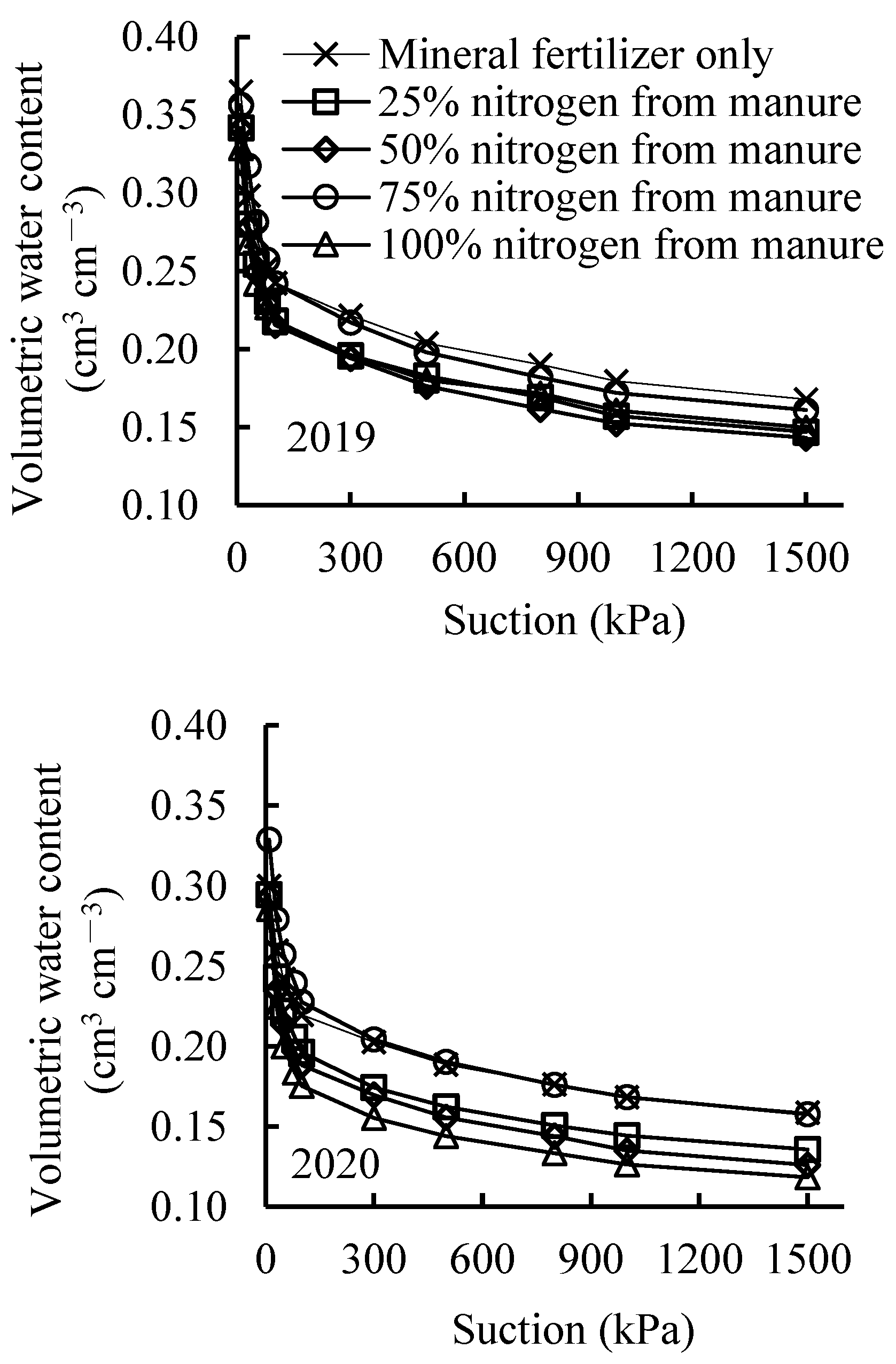
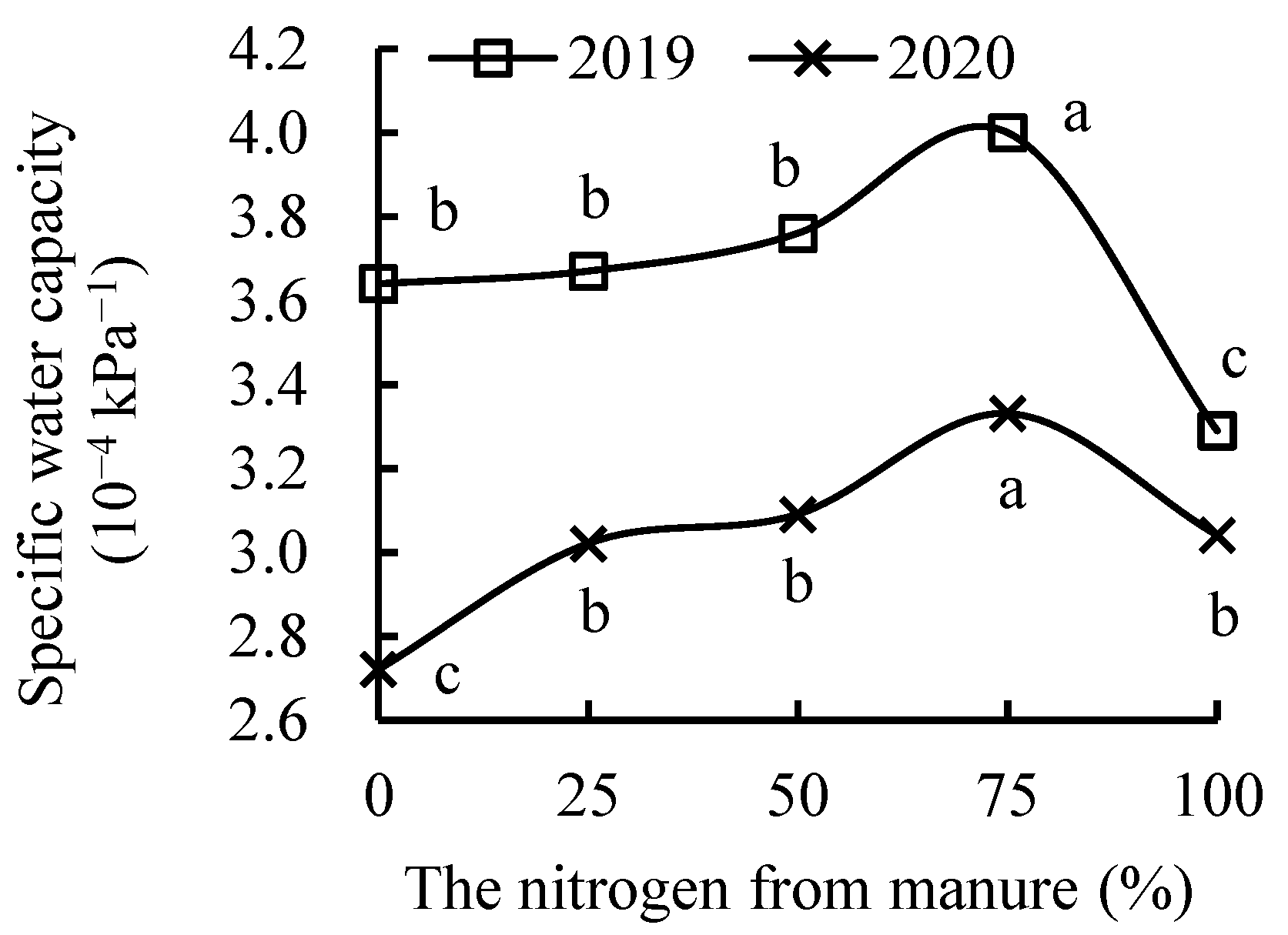
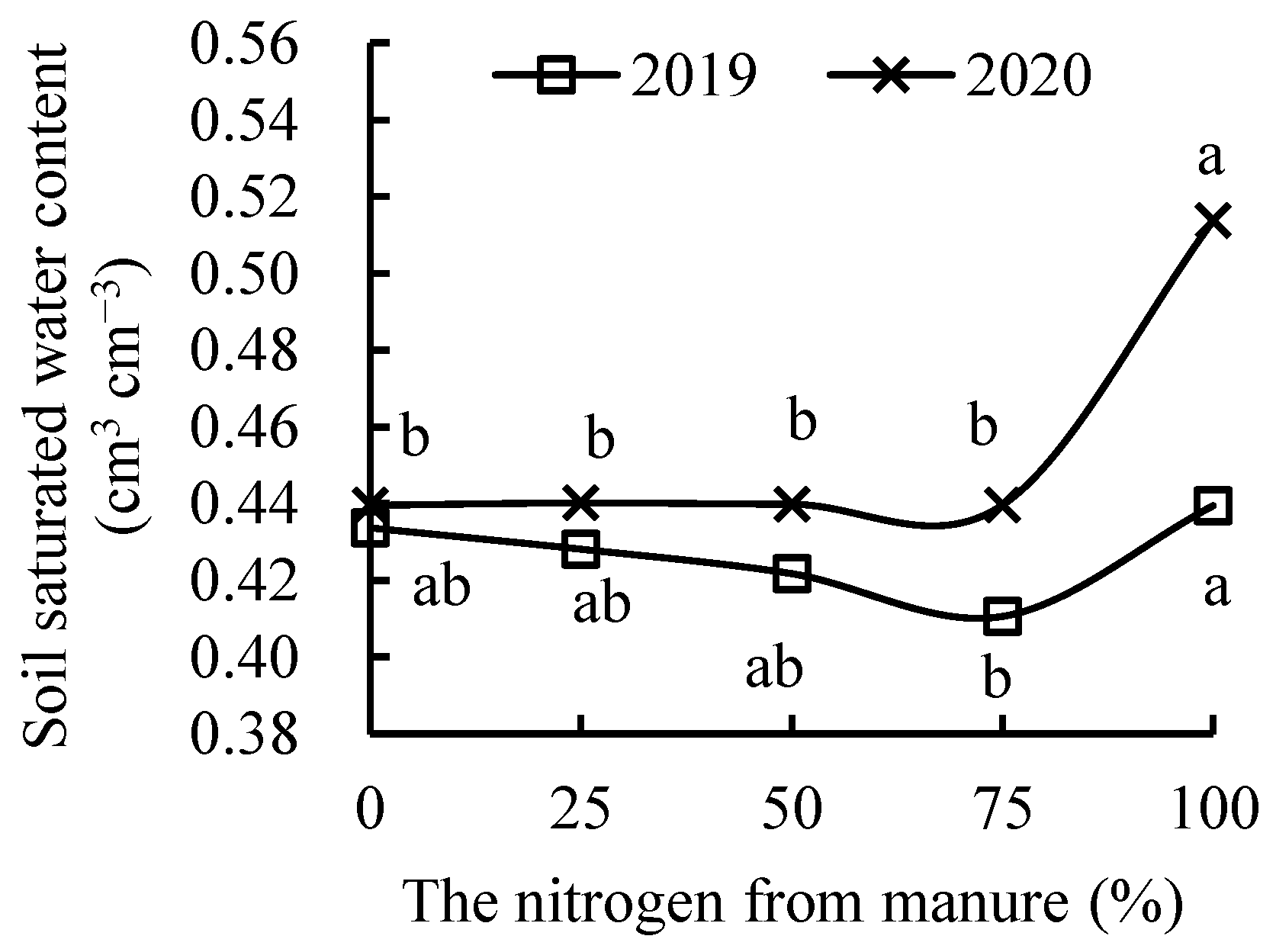
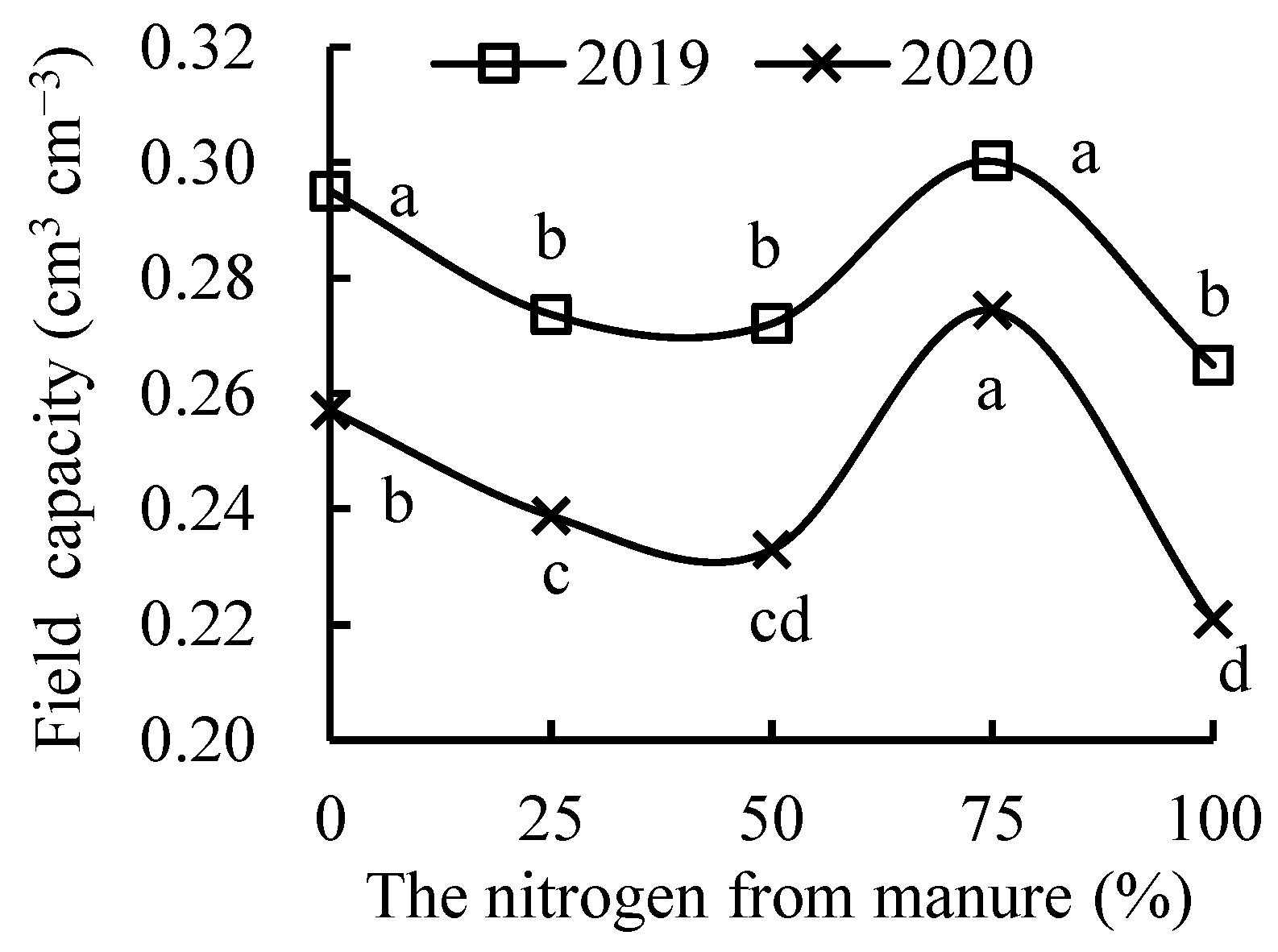
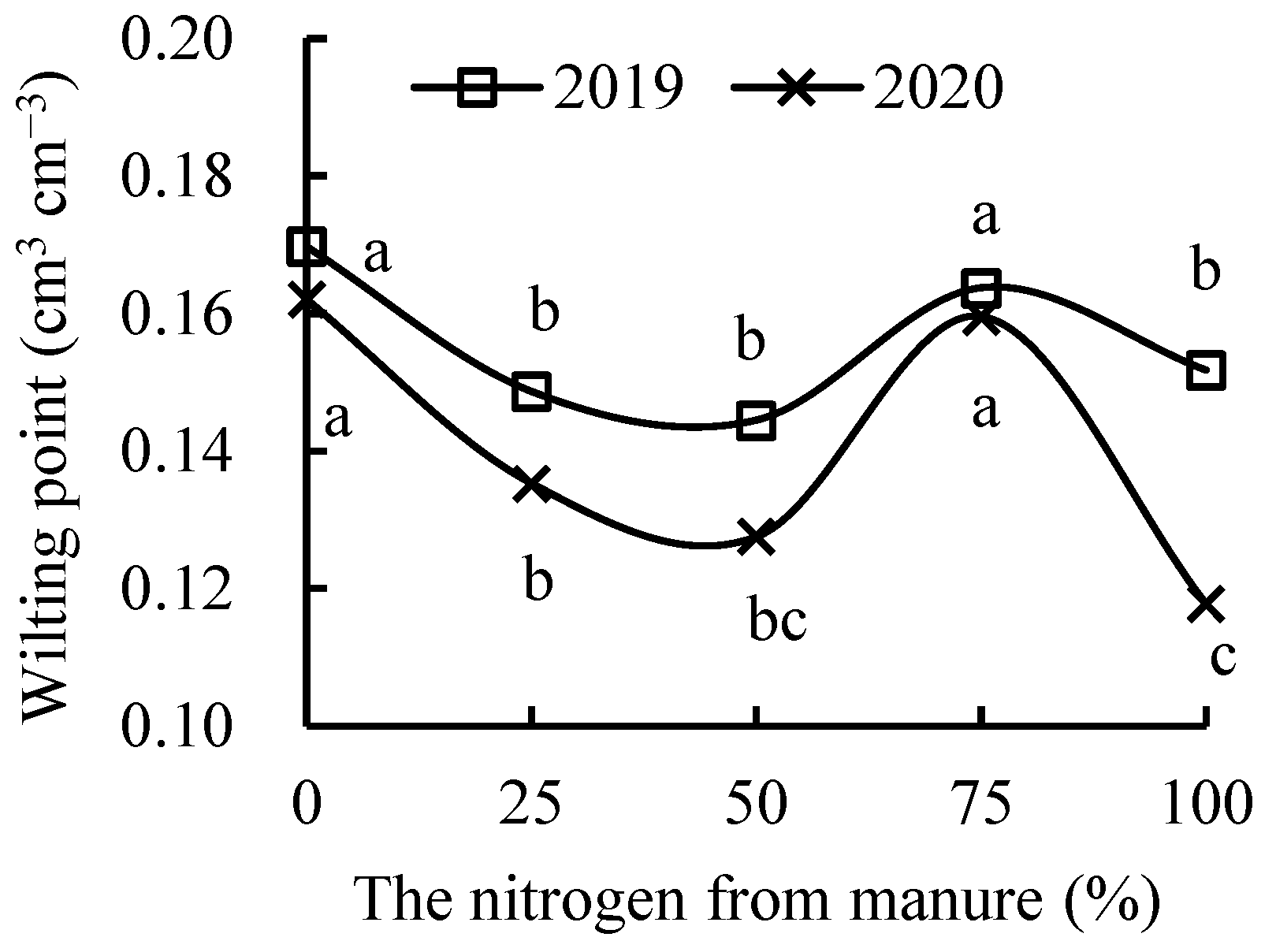
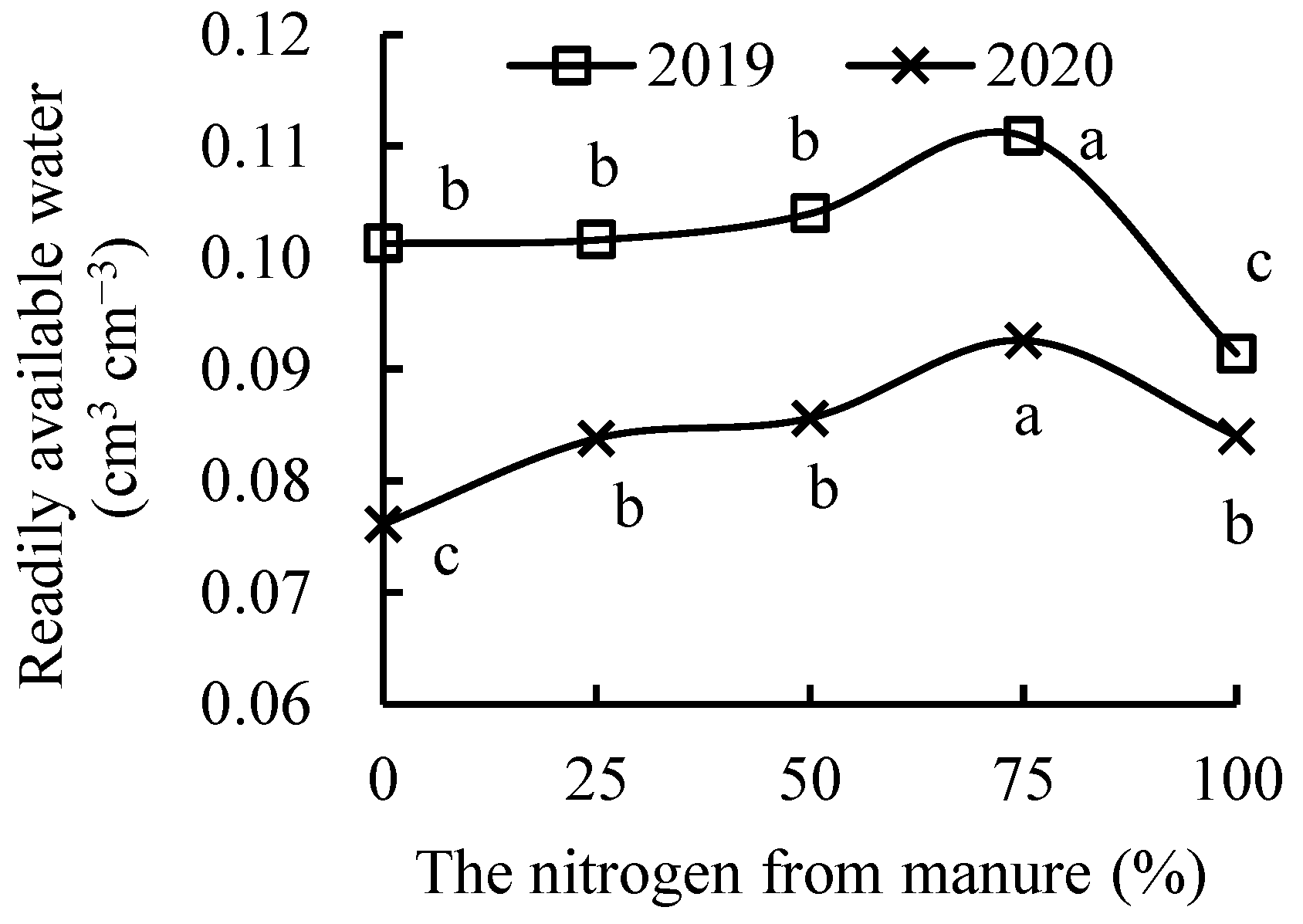
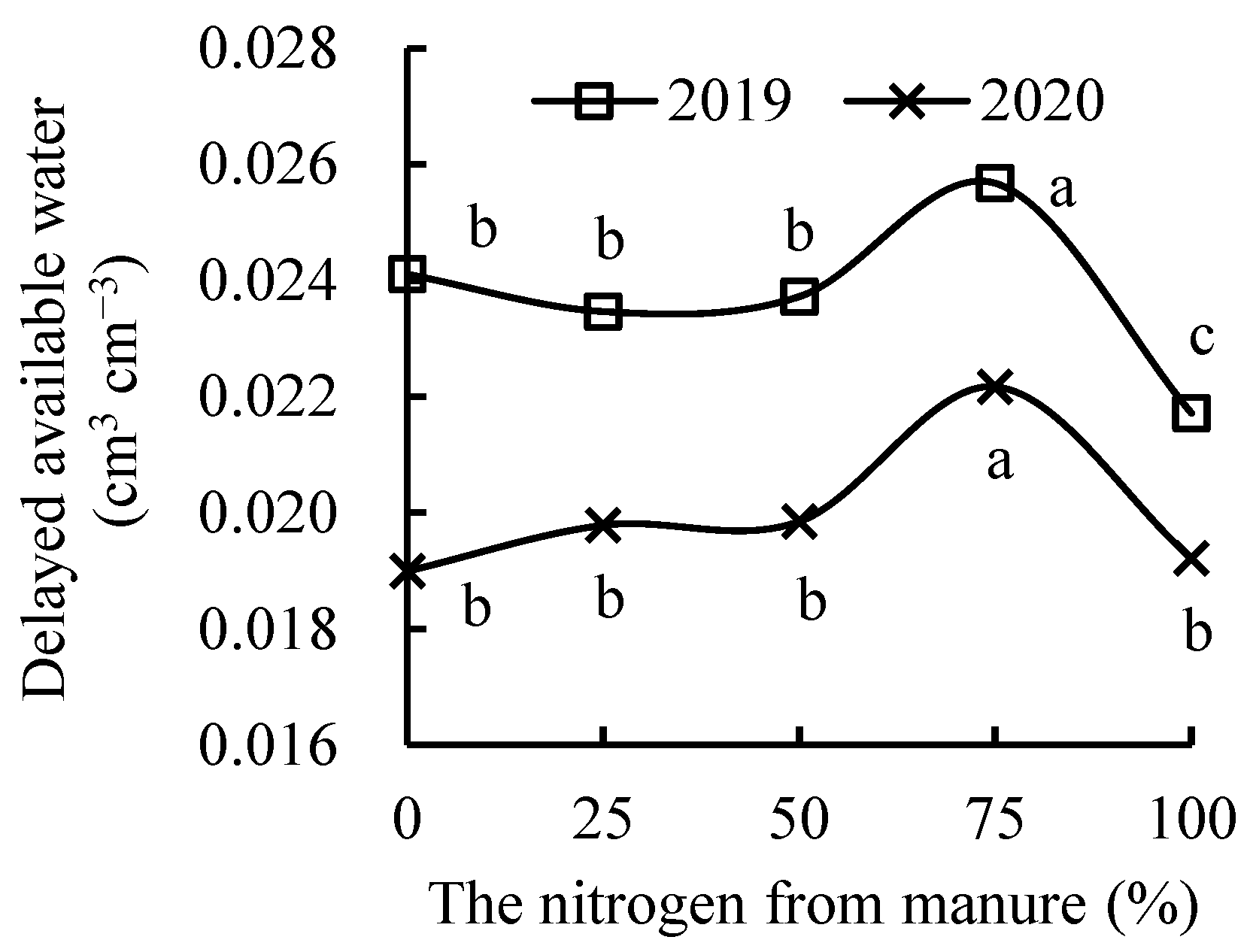
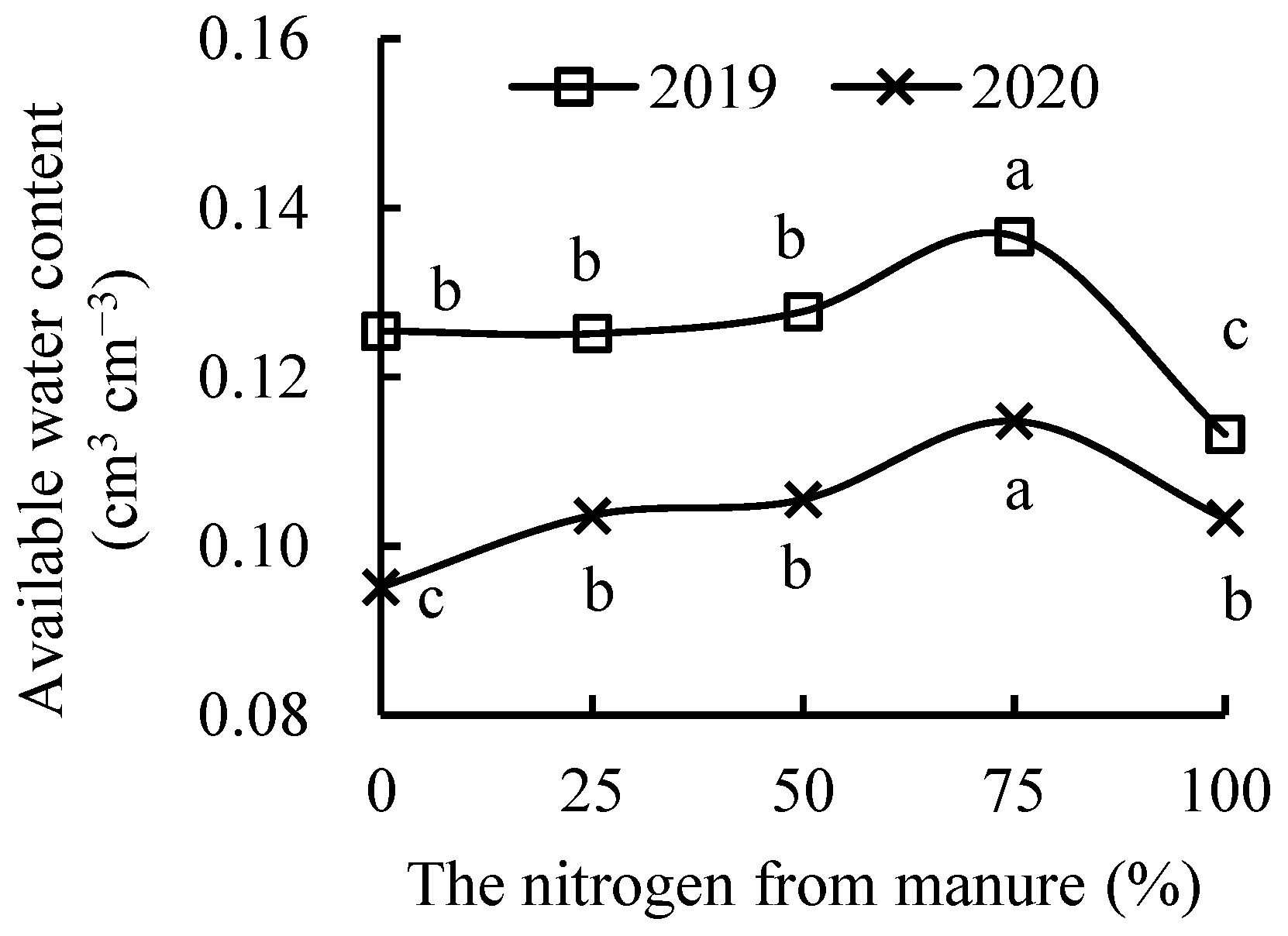
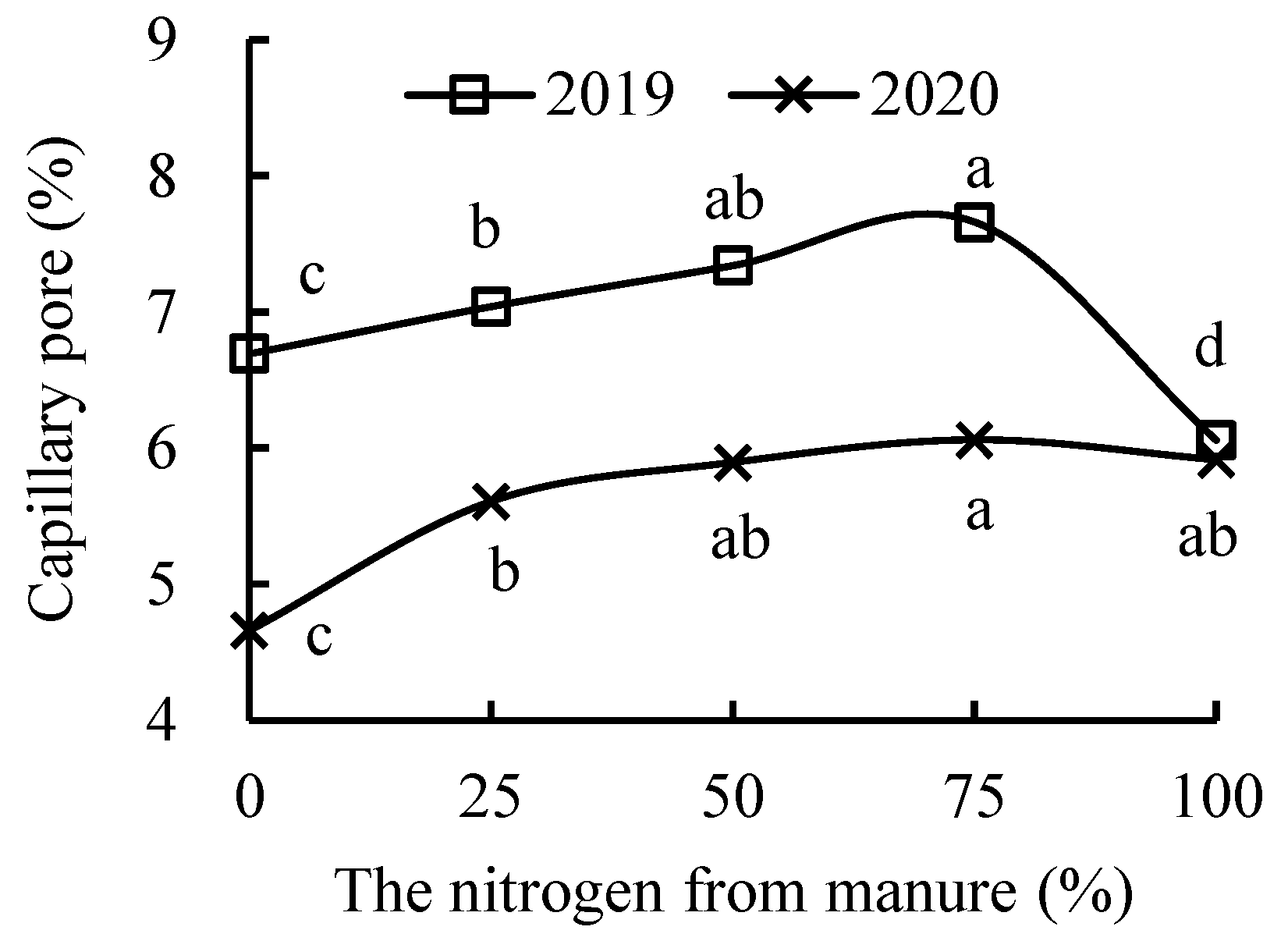
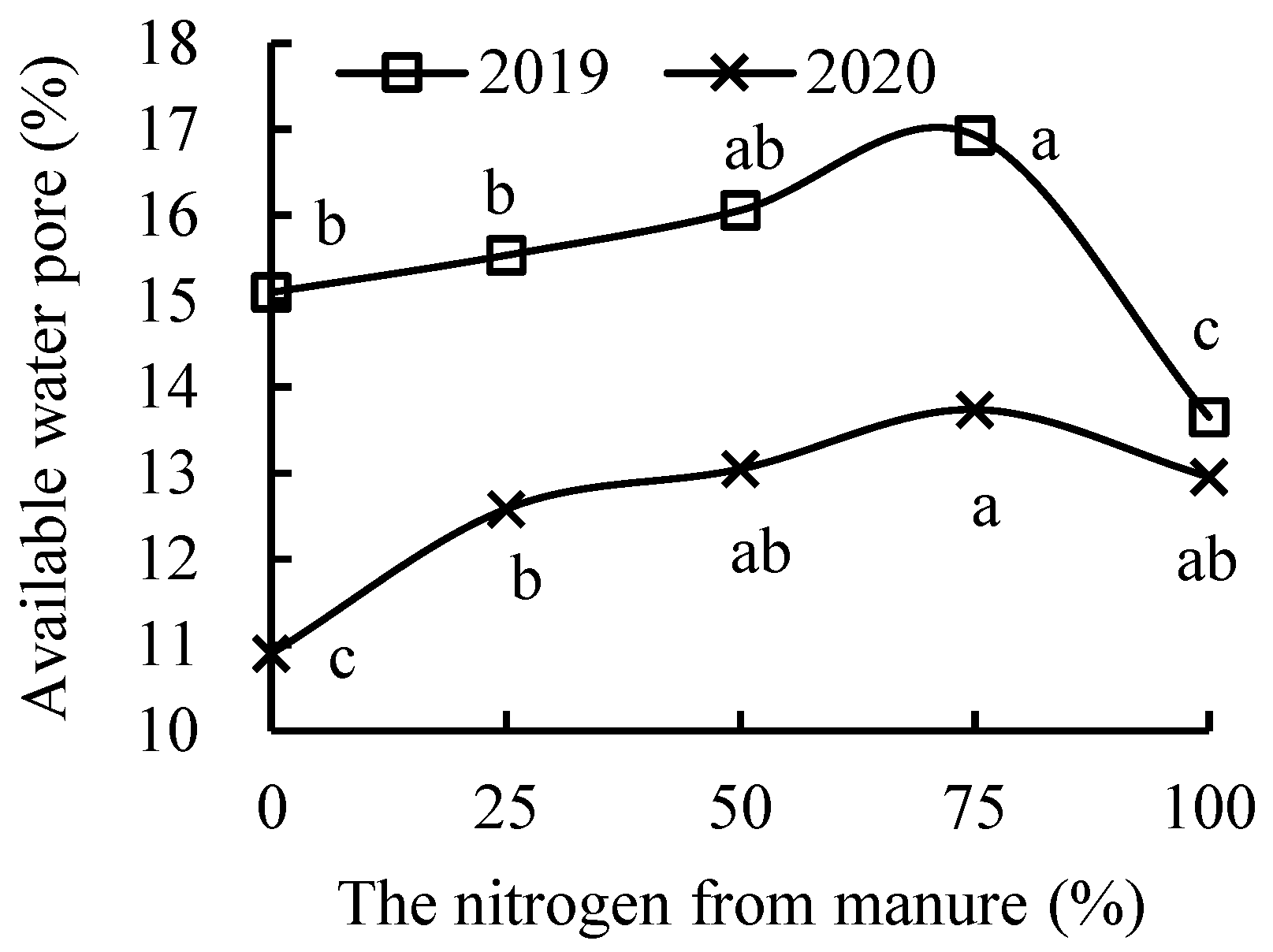
| Treatments | 225 kg ha−1 Nitrogen from Fertilizer | 225 kg ha−1 Nitrogen from Manure |
|---|---|---|
| CK | 100% | 0% |
| (M25) | 75% | 25% |
| (M50) | 50% | 50% |
| (M75) | 25% | 75% |
| (M100) | 0% | 100% |
| Years | Treatments | A | B | R2 |
|---|---|---|---|---|
| 2019 | Mineral fertilizer only | 0.490 | 0.145 | 0.99 |
| 25% nitrogen from manure | 0.479 | 0.160 | 0.99 | |
| 50% nitrogen from manure | 0.486 | 0.166 | 0.99 | |
| 75% nitrogen from manure | 0.524 | 0.159 | 0.99 | |
| 100% nitrogen from manure | 0.441 | 0.146 | 0.99 | |
| 2020 | Mineral fertilizer only | 0.393 | 0.121 | 0.99 |
| 25% nitrogen from manure | 0.402 | 0.149 | 0.99 | |
| 50% nitrogen from manure | 0.405 | 0.158 | 0.99 | |
| 75% nitrogen from manure | 0.451 | 0.142 | 1.00 | |
| 100% nitrogen from manure | 0.393 | 0.165 | 0.98 |
Disclaimer/Publisher’s Note: The statements, opinions and data contained in all publications are solely those of the individual author(s) and contributor(s) and not of MDPI and/or the editor(s). MDPI and/or the editor(s) disclaim responsibility for any injury to people or property resulting from any ideas, methods, instructions or products referred to in the content. |
© 2023 by the authors. Licensee MDPI, Basel, Switzerland. This article is an open access article distributed under the terms and conditions of the Creative Commons Attribution (CC BY) license (https://creativecommons.org/licenses/by/4.0/).
Share and Cite
Wang, X.; Wang, L.; Wang, T. Effect of Replacing Mineral Fertilizer with Manure on Soil Water Retention Capacity in a Semi-Arid Region. Agronomy 2023, 13, 2272. https://doi.org/10.3390/agronomy13092272
Wang X, Wang L, Wang T. Effect of Replacing Mineral Fertilizer with Manure on Soil Water Retention Capacity in a Semi-Arid Region. Agronomy. 2023; 13(9):2272. https://doi.org/10.3390/agronomy13092272
Chicago/Turabian StyleWang, Xiaojuan, Lei Wang, and Tianle Wang. 2023. "Effect of Replacing Mineral Fertilizer with Manure on Soil Water Retention Capacity in a Semi-Arid Region" Agronomy 13, no. 9: 2272. https://doi.org/10.3390/agronomy13092272
APA StyleWang, X., Wang, L., & Wang, T. (2023). Effect of Replacing Mineral Fertilizer with Manure on Soil Water Retention Capacity in a Semi-Arid Region. Agronomy, 13(9), 2272. https://doi.org/10.3390/agronomy13092272






